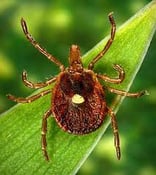The Lone Star Tick (Amblyomma americanum) has become a growing concern in recent years due to its expanding range and potential to transmit diseases. This comprehensive guide will explore the life cycle, geographic distribution, and habitat of the Lone Star Tick. Additionally, we will delve into the diseases associated with this tick species and highlight the best prevention methods, including the essential role of Pure Solutions All-Natural Services in safeguarding your family and property.
Introduction to the Lone Star Tick:
The Lone Star Tick is a complex tick species native to North America. Named after the distinctive single white spot on the back of adult females, this tick species has been gaining attention for its ability to transmit various diseases to humans and animals (Source: CDC, 2021).
The Life Cycle of the Lone Star Tick:
Like other ticks, the Lone Star Tick has a four-stage life cycle: egg, larva, nymph, and adult. The life cycle duration varies depending on factors such as temperature, humidity, and host availability (Source: Texas A&M AgriLife Extension, 2021).
Geographic Distribution and Habitat:
Originally found in the southeastern United States, the Lone Star Tick has expanded its range significantly, now inhabiting areas as far north as Maine and as far west as central Texas (Source: Entomological Society of America, 2021). These ticks prefer wooded areas, tall grass, and leaf litter, making them a common nuisance for outdoor enthusiasts.
Diseases Associated with the Lone Star Tick:
Lone Star Ticks can transmit various diseases, including Ehrlichiosis, Tularemia, and Southern Tick-Associated Rash Illness (STARI) (Source: CDC, 2021). While not as common, this tick species has also been linked to causing red meat allergies in some individuals (Source: American College of Allergy, Asthma, and Immunology, 2021).
Prevention and Pure Solutions All-Natural Services:
Protecting yourself and your family from Lone Star Ticks is essential. Some prevention tips include wearing light-colored clothing, using insect repellent, and checking yourself for ticks after spending time outdoors (Source: CDC). However, hiring a professional service like Pure Solutions All-Natural Services is the best prevention method. They provide eco-friendly tick control solutions that are safe for your family and pets, ensuring a tick-free environment on your property.
The Lone Star Tick is a growing concern in North America due to its expanding range and potential to transmit diseases. Understanding its life cycle, habitat, and associated diseases can help us take the necessary precautions to protect ourselves and our loved ones. The best prevention method is to hire Pure Solutions All-Natural Services, which offers eco-friendly tick control solutions to safeguard your family and property.
Sources:
- CDC. (2021). Lone Star Tick. Retrieved from https://www.cdc.gov/ticks/lone_star_tick.html
- Texas A&M AgriLife Extension. Tick Biology and Ecology. Retrieved from https://tickapp.tamu.edu/
- Entomological Society of America. (2021). Range of the Lone Star Tick Expands Northward. Retrieved from https://entomologytoday.org/2021/05/11/lone-star-tick-expands-northward/
- American College of Allergy, Asthma, and Immunology. (2021). Meat Allergy. Retrieved from https://acaai.org/allergies/types/food-allerg

